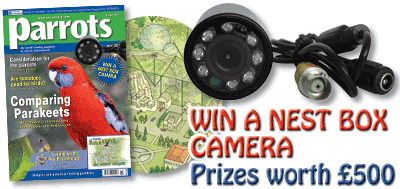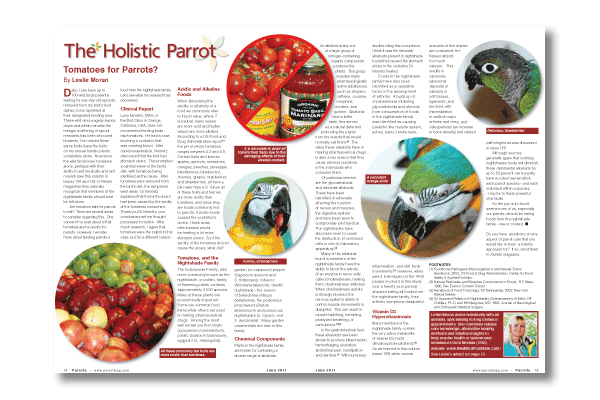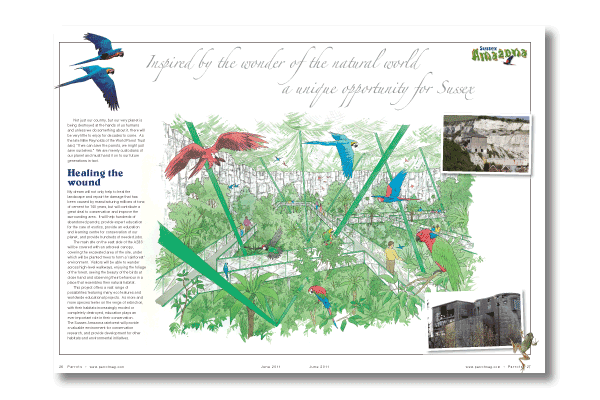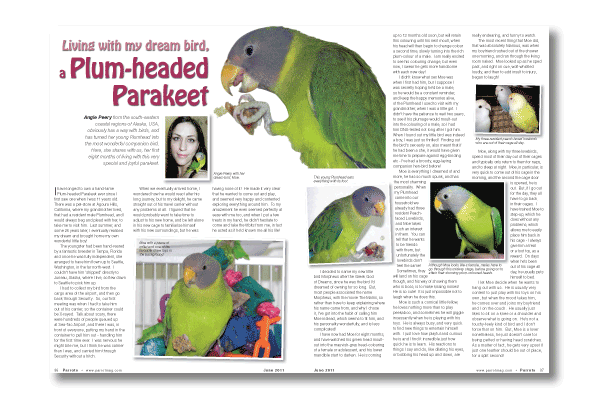
Buy your copy now!
Save money if you subscribe - 12 issues for the price of 11
In this issue...
- Having Empathy for the Parrot Parents - read more
- Tomatoes for Parrots? - read more
- Sussex Amazona - I have a Dream! - read more
- Visit the Sussex Amazona website - click here
- Comparing popular Australian parakeets - read more
- Living with my dream bird, a Plum-headed Parakeet - read more
- News, Bird Alert, Readers Story, and FREE classified advertising

Having Empathy for the Parrot Parents
An online birdkeeper who is also a hobbyist sent me this enquiry about her breeding pair of psittacines:
“I always have a guilty feeling when I remove babies from my parrot parents. I am excited when I have a new chick to feed and raise, but a part of me really goes out to the Mom and Dad. How much trauma do you think they feel when we take their babies from them?”
For many years I have been quite concerned about the health and stress level on psittacine parents who find their chicks stolen away at an early point in their nestbox nurturing phase.
The responsibilities of raising parrots in captivity go far beyond just guaranteeing that the young birds are raised well and provided for, and consideration for breeding pairs is also important. Aviculturists need to realize that nesting parrots are operating on an intimate darkness/sense/touch level when they have new-borns in the nesting chamber. In some ways parents, especially the hen, are in a state of trance with a single focus only, that, being the baby birds. From the early stage when activity is apparent inside the eggs, our hens are totally attentive, and mostly out of sight for fourteen to twenty days after hatch.
Read more in the magazine…
Buy a copy now!

Tomatoes for Parrots?
Daily, I can have up to 100 wild birds patiently waiting for any day-old sprouts, removed from my bird’s food dishes, to be sprinkled at their designated feeding area. These wild ones eagerly swoop down and within minutes the meager scattering of sprout remnants has been devoured. However, I’ve noticed these same birds leave the fruits on my annual tomato plants completely alone. Now since the wild birds leave tomatoes alone, perhaps with their ability to self medicate and self nourish (see this column in issues 134 and 135 of Parrots magazine) they naturally recognize that members of the nightshade family should best be left alone.
Are tomatoes safe for parrots to eat? There are several areas to consider regarding this. One concern I’ve read about is that tomatoes are too acidic for parrots. However, I wonder more about feeding parrots a food from the nightshade family. Let’s see what my research has uncovered.
Read more in the magazine…
Buy a copy now!

Visit the Sussex Amazona website - CLICK HERE
Nestling in an area of outstanding beauty in West Sussex, lies an abandoned cement works, and for 20 years this derelict site has been an eyesore spoiling the breathtaking views of the South Downs. I drive past this site every day as I go to work and can never resist a sneak look over and think how wonderful this place could be for the many parrots and parakeets that are unwanted or abandoned!
Not just our country, but our very planet is being destroyed at the hands of us humans and unless we do something about it, there will be very little to enjoy for decades to come. As the late Mike Reynolds of the World Parrot Trust said, “If we can save the parrots, we might just save ourselves.” We are merely custodians of our planet and must hand it on to our future generations in tact.
Read more in the magazine…
Buy a copy now!

In this second of four articles, Jill Perry compares three more popular Australian parakeets.
• Pennant’s or Crimson Rosella (Platycercus elegans)
• Port Lincoln Parrot (Barnardius zonarius)
• Rock Pebblers or Regent Parrot (Polytelis anthopeplus)
Read more in the magazine…
Buy a copy now!

Angie Peery from the south-eastern coastal regions of Alaska, USA, obviously has a way with birds, and has turned her young Plumhead into the most wonderful companion bird. Here, she shares with us, her first eight months of living with this very special and joyful parakeet.
I have longed to own a hand-tame Plum-headed Parakeet ever since I first saw one when I was 11 years old. There was a pet-store at Agoura Hills, California, where my grandmother lived, that had a resident male Plumhead, and I would always beg and plead with her, to take me to visit him. Last summer, and some 25 years later, I eventually realised my dream and brought home my own wonderful little boy!
The youngster had been hand-reared by a fantastic breeder in Tampa, Florida and once he was fully independent, she arranged to have him flown up to Seattle, Washington, in the far north-west. I couldn’t have him ‘shipped’ directly to Juneau, Alaska, where I live, so flew down to Seattle to pick him up.
I had to collect my bird from the cargo area of the airport, and then go back through Security. So, our first meeting was when I had to take him out of his carrier, so the container could be X-rayed. Talk about scary, there were hundreds of people queued up at Sea-Tac Airport, and there I was, in front of everyone, putting my hand in the container to pull him out - handling him for the first time ever. I was nervous he might bite me, but I think he was calmer than I was, and carried him through Security without a hitch.
Read more in the magazine…
Buy a copy now!






